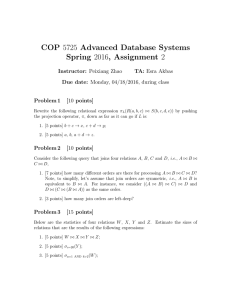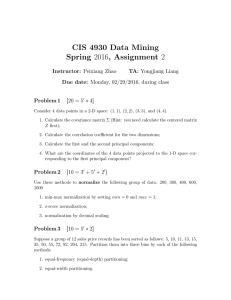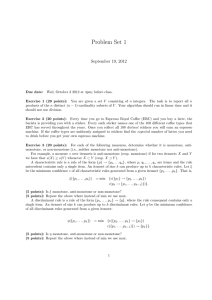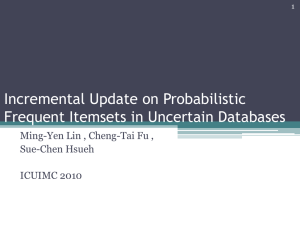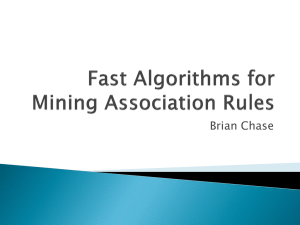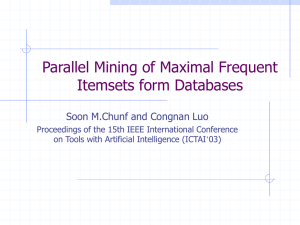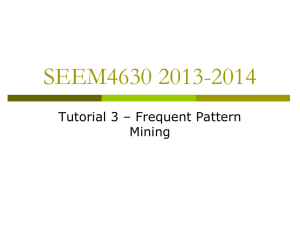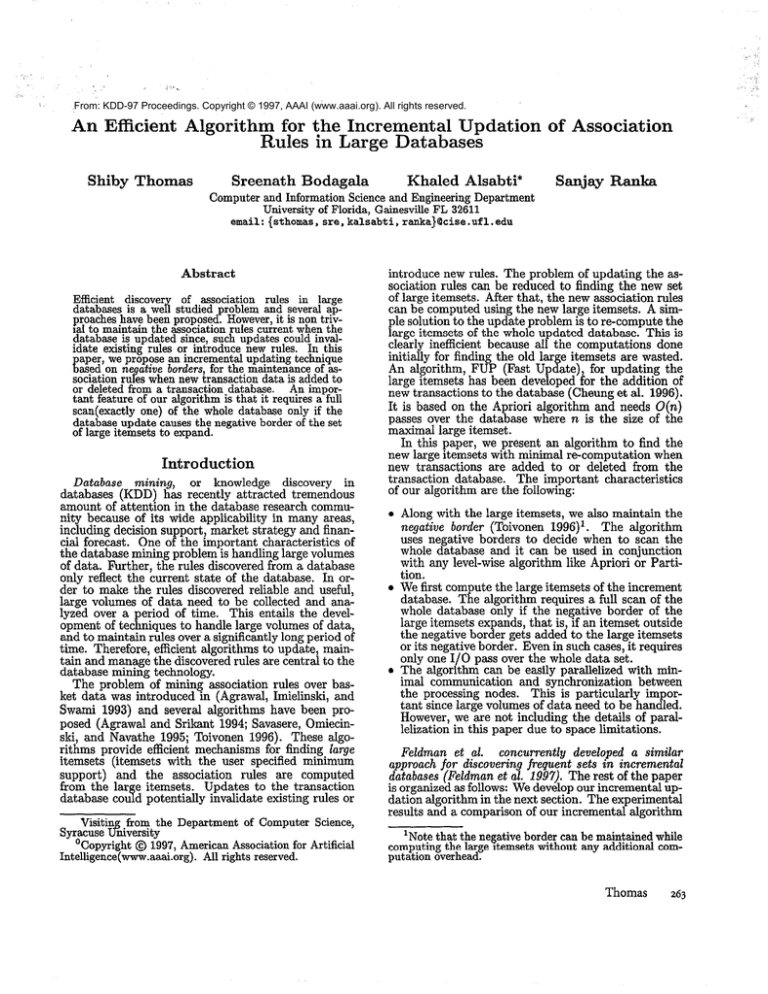
.’
From: KDD-97 Proceedings. Copyright © 1997, AAAI (www.aaai.org). All rights reserved.
An Efficient
Algorithm
Shiby Thomas
for the Incremental Updation
Rules in Large Databases
Sreenath Bodagala
Khaled Alsabti*
of Association
Sanjay Ranka
Computer and Information Science and Engineering Department
University of Florida, Gainesville FL 32611
email: {sthomas, sre,kalsabti,ranka}@cise.ufl.edu
Abstract
Efficient discover of association rules in large
databases is a we 1y
1 studied problem and several approaches have been proposed. However, it is non trivial to maintain the association rules current when the
database is updated since, such updates could invalidate existing rules or introduce new rules. In this
paper, we propose an incremental updating technique
btied on tie ittive borders, for the maintenance of aSsociation ru fes when new transaction data is added to
or deleted from a transaction database. An important feature of our algorithm is that it requires a full
scan(exactly one) of the whole database only if the
database update causes the negative border of the set
of large itemsets to expand.
Introduction
Database m ining, or knowledge discovery in
databases (KDD) has recently attracted tremendous
amount of attention in the database research community because of its wide applicability in many areas,
including decision support! market strategy and financial forecast. One of the important characteristics of
the database m ining problem is handling large volumes
of data. Further, the rules discovered from a database
--I- reutx~
--P--J. Al-uruy
~1x5CiZP3lt SiEikieO f the dizt&hizSe.ITi O F
der to make the rules discovered reliable and useful,
large volumes of data need to be collected and analyzed over a period of time. This entails the development of techniques to handle large volumes of data,
and to m a intain rules over a significantly long period of
time. Therefore, efficient algorithms to update, m a intain and manage the discovered rules are central to the
database m ining technology.
The problem of m ining association rules over baslmt
a."" &ha
-vu-
xxrs~
,. YY intrm-hrd
I--Y*v...."I..
in fAm~~.ml
-a.
\"~'.a.,
.a-, Tmielinaki
--*-.".--Y-.-,
and
-a-u
Swami 1993) and several algorithms have been proposed (Agrawal and S&ant 1994; Savasere,O m iecinski, and Navathe 1995; Toivonen 1996). These algorithms provide efficient mechanisms for finding large
itemsets (itemsets with the user specified m inimum
support) and the association rules are computed
from the lar e itemsets. Updates to the transaction
database cou7 d potentially invalidate existing rules or
Visitin from the Department of Computer Science,
Syracuse ug.mversity
‘Copyright @ 1997, American Association for Artificial
Intelligence(www.aaai.org). All rights reserved.
introduce new rules. The problem of updating the association rules can be reduced to finding the new set
of large itemsets. After that, the new association rules
can be computed using the new large itemsets. A simple solution to the update problem is to re-compute the
large itemsets of the whole updated database. This is
clearly inefficient because all the computations done
initially for finding
---- the
_- old large itemsets are wasted.
An algorithm, FUP (Fast Update), for updating the
large itemsets has been developed for the addition of
new transactions to the database (Cheung et al. 1996).
It is based on the Apriori algorithm and needs O(n)
passes over the database where n is the size of the
maximal large itemset.
In this paper, we present an algorithm to find the
new large itemsets with m inimal recomputation when
new transactions are added to or deleted from the
transaction database. The important characteristics
of our algorithm are the following:
Along with the large itemsets, we also m a intain the
negative border (Toivonen 1996)r. The algorithm
uses negative borders to decide when to scan the
whole database and it can be used in conjunction
with any level-wise algorithm like Apriori or Parti-
tinn
"A.,...
W e first compute the large itemsets of the increment
database. The algorithm requires a full scan of the
whole database only if the negative border of the
large itemsets expands, that is, if an itemset outside
the negative border gets added to the large itemsets
or its negative border. Even in such cases,it requires
only one I/O pass over the whole data set.
The algorithm can be easily parallelized with minimal communication and synchronization between
the orocessinn nodes. This is narticularly important-since lark volumes of data heed to be handled.
However, we are not including the details of parallelization in this paper due to space lim itations.
FeIdcan et -al. concurrently developed a similar
approach for discovering frequent sets in incremental
databases(Feldman et al. 1997). The rest of the paper
is organized as follows: W e develop our incremental updation algorithm in the next section. The experimental
results and a comparison of our incremental algorithm
‘Note that the negative border can be maintained while
computing the large itemsets without any additional computation overhead.
Thomas
263
‘i
,,.
with FUP is presented next. The last section concludes
the paper and outlines possible extensions.
Incremental
upckxkxg
of association
In this section we develop an efficient method for updating the association rules when the database is updated. Since we deal mainly with basket data, database
update effectively means addition of new transactions
to the database or deletion of existing transactions.
Assuming that the two thresholds, minimum support
nn+
nh.,m,-m
anuA nl\nGA,-.,\nc.
Ir”IIIIuCjllLcs,rln.
U” U”U
LLLa.qjC+hn
“Us ..,A.nta
upuawz nrnhlom
pvur-au r..r.m
LOJU
be reduced to finding the new set of large itemsets.
After that, the new association rules can be computed
from the new large itemsets. In this paper we concentrate on updating the large itemsets. Before we explain
the algorithm in detail, we explain some results which
aid in presenting the algorithm.
Computing
N&d(L)
from
L
In this subsection, we explain how to compute the
negative border (n/ad(L)) of a set of large itemsets L.
This can be accomplished by repeating the join and
prune steps of the aptiori-gen function in the apriori
algorithm (Agrawal and Srikant 1994 . This computai
tion can be done using only the set o 4 large itemsets L
and the database need not be scanned.
Definition
1 The negative border A&d(L), of a coL
lection of items& L i s defined as fpllows: Given a
colEection L 5 P(R) of sets, closed wath respect to the
set inclusion relation, the negative border Nl3d(L) of L
consists of the minimal itemsets X C R not in L (Mannila and Toivonen
1996).
The apriori-gen function takes as argument Lk-1,
the set of all large (Ic-1)-itemsets. It returns a superset
of the set of all large Bitemsets.
function apriori-gen(Le-1)
for-each p and q E &-.I
do
zf p.iteml = q.ii!eml ,..., p.itemk-2 = q.itemk-2
and v.itemk-1
<
q.itemk-1 then insert
into ck
p.iterGl, p.item2 , . . . ,p.itimk-l,q.itemk-1
fOT each C E ck
delete c from ck if some (k - l)-subset of C is not
in .?&1
Figure 1: A high-level description of the apriori-gen
function
The negative border consists of all itemsets that were
candidates of the level-wise method which did not have
enough support. That is, NBd(Lk) = Ck - LI, where
ck is the set of candidate Ic-itemsets, Lk is the set of
large Ic-itemsets and NBd(Lk) is the set of k-itemsets
in Nad(L).
Therefore, LkU Nad(Lk) = ck. The
apm’ori-gen function uses oniy Lb-1 to compute &.
Lemma
1 All 1-itemsets should be present in LU
NBd(L).
Addition
of new transactions
When new transactions are added to the database,
an old large itemset could potentially become small in
the updated database. Similarly, an old small itemset
could potentially become large in the new database.
264
KDD-97
function negativeborder-gen(L)
S lit Li?to Ll,+:!,...,
L, where n is the size of the
P
fo~%eP3~,stet. ffkdo
compute ck+l using uprioTi-gen(&)
LU A&Z(L) = Ui=2,...,rr+l ck UIl where 11 is the set
of 1-itemsets.
Figure 2:
A high-level
negativeborder-gen function
description
of
the
In order to solve the update problem efficiently, we
maintain the large itemset and the negative border
along with their support count in the database. That
is, for every s E L U NI3d(L , we maintain s.count.
In the rest of this section, d B denotes the original
database, db denotes the transactions that are newly
added and DB+ denotes the updated database. Also
LDB, Ldb and LDB+ denotes the large itemset and
NBd(LDB), NBd Ldb) and NZ?d LDB+) denotes the
negative border o6 the ori inal 6 atabase, increment
database and the updated if atabase respectively.
Lemma 2 Let s be any itemset such that s # LDB.
Then s E LDB+ only ifs E Ldb.
Proof:
Assume that there exists an itemset s such
that s E LDB+, s @ LDB and -‘: $ Ld”. ~~~ to,-($)
and t&(s) be the number of transactions in DB and
db respectively containing the itemset s. Also let tDB
and tdb be the total number of transactions in DB and
db respectively. Since s # LDB and s # Ldb,
tDB (s)
< m&Support
tDB
and -tdb(S)
< minsupport.
tdb
From these two equations, it can be shown that
tDB (8) + tdb(S)
tDB
< minsupport
+ tdb
Therefore, s @LDBf which is a contradiction. 0
Lemma
3 Let s be an itemset such that s E NI?d(L).
Then all possible subsets of s must be present in L.
Proof:
For a contradiction, let t be an itemset such
that t C s and t $?!L. By the definition of negative
border, NBd(L) consists of the mine’mal itemsets not
in L. Since t $ L, s is not a minimal itemset not
in L. Therefore s cannot be in NBd(L),
which is a
contradiction. cl
Theorem
1 Let s be an itemset such that s $ZLDB U
Nl?d(LDB)
and s E LDB+. Then there exists an item.-..a.A
,....A
..,..J zL en- urDB+
3Gb
I, D’
UGI‘.a,+
Cl‘U‘+0 rc a, I‘ rc ,”rrnafrDB\
UU(JJ 1 (LILLL
That is, some subset of s has moved from Nt3d(LDBj
to LDB’
Since s E LDB+ all possible subsets of s
should be in LDBS. But Lll the subsets of s cannot
be in LDB because if that was the case, then s should
be present in at least NBd(LDB) if not in LDB itself.
By our assumption, s $ L DB UNBd(LDB). Therefore,
Proof:
there exists an itemset t such that t C s and t $ LDB.
Now we have two cases.
Case i : t E Ni3d(LDB).
In this case, t E LDB+
since s E LDBf and t c s.
Therefore, we have found a subset of s which has moved
from N13d(LDB) to LDB+.
Case ii : t # N13d(LDB).
But, we know that
That is, t $! LDB UNad(LDB).
t E LDB+ since s E LDB+ and t c s. Therefore,
t r$ LDB U N13d(LDBl and t E LDBf and hence we
c& apply the th6oredrecursively on t. Note that the
size of t is less than the size of s since t c s.
When this is applied recursively, there are two possibilities. First is, for some subset oft, case i holds true
in which case, there is a subset of t which has moved
from N13d(LDB) to LDB+, and hence the theorem is
proved. Otherwise, t will finally become a 1-itemset.
By Lemma 1, we know that all I-itemsets are present
in LDB U N13d(LDB). Since t 6 LDB, t E NBd(LDB)
which contradicts the assumption for case ii. That is,
case ii is not possible if t is a 1-itemset. 0
By theorem 1, if none of the itemsets move from the
negative border to the large itemset, we do not need
to scan the whole database. Even in cases where some
itemsets move from the negative border to the large
itemset, a complete ..----AdatabaseL ^^^__^^
scan is required only if
the negative border aqJL%lKls
uecaLlse,for aii ihe itemsets in the negative border, we can derive the updated
support count easily.
We maintain the support count for all itemsets in the
large itemset and the negative border. First, we compute the large itemset in db using a level-wise algorithm
like Apriori or Partition. Simultaneously we count the
support for all itemsets in LDB U N13d(LDB) in db. If
an itemset t E LDB does not have minimum support
in DB U db, then t is removed from LDB. This can be
easily checked since we know the support count for t
in DB and db. The change in LDB could potentially
change Nf3d(LDB) also. Therefore, we have to recompute the negative border using the negativeborder-gen
function explained in subsection .
On the other hand there could be some new itemsets which become large in the updated database. Let
s be an itemset which gets added to the large itemset
of the updated database. By Lemma 2, we know that
s has to be in Ldb. We also know by theorem 1 that
some subset of s must move from N13d(LDB) to LDB’.
For each itemset s E Ldb, we check if s gets the minimum support to move from NZ3d(LDB) to LDBf. If
none of the itemsets in Nl?d(LDB) gets the minimum
support, no new itemsets will be added to LDBf. If
some itemsets in N#d(LDB)
gets the minimum support move them to LDB+ and recompute the negative
# LDB U NBd(LDB),
border. If LDB+ U Nl?d(LDB+)
we have to find the negative border ciosure of L”“+
and scan the entire database
once to find the updated large itemset and negative horder. The negative border closure of L is found by repeatedly finding
L = L U Nl3d L) until L does not grow.
During the a atabase scan, all the itemsets which are
in the ne ative border closure that were not originally
in L UN B d(L) are used as the candidate itemsets and
function Update-Large-Itemset(LDB,
//DB
NBd(LDB),
db)
and db denote the number of transactions in
the original database and the increment database
respectively.
Compute Ldb
for each itemset a E LDB
h(8)
= number of
LDB+ =
4
for each itemset a E LDB do
if
(tDB(3)
+ tdb(8))
> TlZiTt3UjJ
* (DB
-I- db) then
LDB+ = ~~~~ u .s
for each itemset a <idb do
and (tDB(8)
ifs # LDB and a E NBd(LDB)
t&(8)) . __ 1
-I- db) then
.
- minaup- * (DB
DB+ =GDB+~~
’
if i$kd$$+;fnen
-I-
negativeborder-gen(LDB+)
else N13d(LDBJr)=
if iDz FD%fd(LDB)
NBd(LDB)
# LDB+ U M3d(LDB+)
then
repeat
compute S = 5’U NBd(S)
until S does not grow
LDB+ = {Z E Slaupport(z) 1 minsup}
//support(x) is the support count of x in DB U db
JvBd(L DB+) = negativeborder-gen(LDB+)
Figure 3: A high-level description of the Update-LargeItemset function
their support count is computed. The candidate set
can further be pruned by applying an optimization
while finding the negative border closure. It can be
observed that an itemset which is not large in the increment database (db) cannot get added to the updated
set of large itemsets. Therefore, such itemsets can be
pruned at each step of the negative border closure computation to get the pruned negative border closure.
However, the support count of these pruned itemsets
should also be found since they may potentially be in
the updated negative border.
Deletion
of existing transactions
Similar to the case where new transactions are added
to the database, the large itemset and its negative border could potentially change when some existing transactions are deleted from the database. As in the former
case, we maintain the large itemset and the negative
border along with their support count in the database.
Let DB- denote the updated database and LDB- and
N13d(LDB-)
denote its large itemset and negative border respectively.
Lemma 4 &St s be an itemset such that s E LDB.
Then s # LuD- only ifs E Lao. That is a large itemaet
s will become small only if s E Ldb.
This lemma
lemma 2.
can be proved
in the same way as
The al orithm to compute the large itemset and the
negative %order of DB- is similar to the one in the case
where new transactions are added to the database.
Thomas
265
Experimental
Results
We conducted a set of experiments to compare the
performance of our incremental algorithm. The experiments were performed on a Sun SPARCstation 4
running SunOS 5.5. In this section, we report on the
results of some of those experiments.
The experiments were performed on synthetic data
generated using the same technique as in (Agrawal and
Srikant 1994). The dataset used for the baseline experiment was T10.14.DlOOK (Mean size of a transaction
= 10, Mean size of maximal potentially large itemsets
= 4, Number of transactions = 100 thousand). The
increment database is created as follows: We generate
100 thousand transactions, of which (100 -d thousand
is used for the initial computation and d t h ousand is
used as the increment, where d is the fractional size (in
r\mnnd..~mn\
prjr L~UUa.Ejrs,
,4
"L
+hn
"I1.2
:mmnmont
U&b,1 cxll-cjll".
Conclusions
ZT,
1 presented an eificient, incrementai updation
we nave
algorithm for the maintenance of the association rules
discovered by database mining. Our algorithm strives
to reduce the I/O requirements for updating the set
of large itemsets. This is achieved by maintaining the
large itemsets and the negative border along with their
support counts. The whole database is scanned only if
reauired and that too just once. This incremental UPdaiion technique can be used in conjunction with aiiy
of the level-wise algorithms like Apriori and Partition.
Further? our algorithm is applicable to addition as well
as deletion of transactions.
18
16
14
12
s"
1
itemsets generated by Apriori. However, FUP may require 0(n) passes over the database where n is the size
of the maximal large itemset.
The most important feature of our incremental updation algorithm is that the whole database is scanned
only when required (and that too only once), thereby
reducing the I/O requirements drastically. Computing
the negative border ciosure may increase the size of the
candidate set. However, a majority of those itemsets
would have been present in the original negative border or large itemset. Only those itemsets which were
not covered by the negative border need to be checked
against the whole database. As a result, the size of
the candidate set in the final scan could potentially be
much smaller as compared to FUP.
':
6
References
4
2
0
2.0
1.5
0.33
sl;;pon
Th%old
0.25
cin"k$
Figure 4: Performance Ratio
We compare the execution time of the incremental
algorithm with respect to running Apriori on the whole
data set. Figure 4 shows the speed up of the incremental algorithm over Apriori for different minimum
support thresholds. We report the results for increment sizes of l%, 2%, 5% and 10%. From the raph,
it can be seen that the incremental al orithm aca ieves
speed up of about 3 to 20. The algorit 1 m shows better
speed up for medium support threshold than low and
high support thresholds. At high support thresholds,
the number of large itemsets is less and hence it is less
costly to run Apriori on the whole database. At low
support thresholds., the probability of the negative border expanding is higher and as a result the incremental
algorithm may have to scan the whole database. Also,
the speed up is hi her for smalier increment sizes since
the incremental aKgorithm needs to process less data.
Comparison
with FUP
The framework of FUP (Cheung et al. 1996) is similar to that of Apriori and contains a number of iterations. Each iteration is associated with a complete
scan of the whole database and in iteration Ic all the
large k-itemsets are found. The candidate sets for iteration k + 1 are generated based on the large itemsets
t-,,.,A
:+.w.n+;nn
I . ~hnonoe-l.,nnCl7TTP
nxro,. LLyIAvII
An&w;
.&AII.zoyzcx4 up"vr A "A "VljA
l”UllU :n111.
llocx
a.UI”Um
can be main1 attributed to the reduction in the number of candi Bate itemsets. It uses the lar e itemset of
the original database to filter and prune t %e candidate
266
KDD-97
R. Agrawal, T. Imielinski, and A. Swami. Mining
Association Rules between Sets of Items in Large
Databases. In Proceedings of the ACM SIGMOD International Conference, May 1993.
zgA rawal and R. Srikant. Fast Algorithms for MinR ssocratlon Rules. In Proceedzngs of the 20th
VLDB, Santiago, Chile, September 1994.
D. W. Cheung, J. Han, V. T. Ng, and C. Y.
Wong. Maintenance of Discovered Association Rules
in Large Databases: An Incremental Updatin Technit-me. In Pmredinoc
New
9.
- -4--zl_.ac of the I.$& IQJJE. I _.
_- 8_.rlcnn
.--.-ILz
2;>8iana, February <996:R. Feldman, Y. Aumann, A. Amir, and H. Mannila. Efficient Algorithms for Discovering Frequent
Sets in Incremental Databases. In Proceedings of the
1997 SIGMOD
Workshop
on DMKD,
Tucson,
Ari-
zona, May 1997.
H. Mannila and H. Toivonen. On an Algorithm for
Finding all Interesting Sentences. In Cybernetics and
$yatems,
Volume -II, The 23th Evropean Meeting
on
Cybernetics and Systems Research, Vienna, Austria,
April 1996.
A. Savasere, E. Omiecinski, and S. Navathe. An Efficient Algorithm for Mining Association Rules in Lar e
Databases. In Proceedings of the blst VLDB, Zuric % ,
Switzerland, September 1995.
Hannu Toivonen. Sampling Large Databases for ASsociation Rules. In Proceedings of the 22nd VLDB,
Mumbai(Bombay), India, September 1996.

